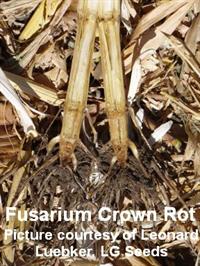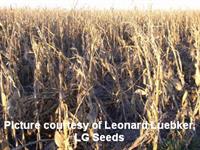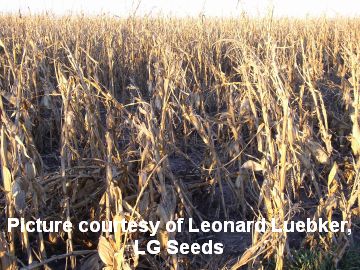AGRONOMICSUPPORT
YOU CAN TAKETO THE FIELD
Fusarium Crown and Root Rots
Fusarium crown rot and Fusarium root rot in corn are in the class known as fusarium pathogens. Not only does it affect corn, gardeners may also see this in vegetables, shrubs, trees and ornamental plants. The pathogen is wide spread, overwinters as mycelium, and found on crop residue as well as in the soil. For this pathogen to thrive, it requires the pathogen to be present, a susceptible host, and the proper environment to accommodate growth.

Fusarium crown rot favors hot dry conditions during the growing season. This frequently occurs after earlier spring wet periods. With its presence in the crown, the plant will start to show a darkened area at the tip of the crown. It may be a lighter tan color to start, and progress to a blackish/brown when advanced. This infection disrupts the water and nutrient flow to the plant. Once established, it may move downward through the root system causing root rot, or the appearance of it.
 Fusarium root rot on the other hand, favors wet, compacted soil conditions. This fusarium, which starts in the roots, also disrupts the water and nutrient flow to the plant. Roots will have the darkened brownish-black color. From the roots, it may progress its way up through the crown, and continue up the stalk given the proper environmental conditions.
Fusarium root rot on the other hand, favors wet, compacted soil conditions. This fusarium, which starts in the roots, also disrupts the water and nutrient flow to the plant. Roots will have the darkened brownish-black color. From the roots, it may progress its way up through the crown, and continue up the stalk given the proper environmental conditions.
In either case of the root or crown rot, or both in conjunction with each other, plants are subject to less water and nutrients, with potential premature death. Likewise, plants are also weakened for other invasive stalk rots to occur too. These may include Anthracnose, Gibberella, Diplodia and Charcoal rot. When other stalk rots are evident, it is difficult to distinguish which of the diseases was the primary and which was the secondary to present itself in the field.

At this point in the growing season, nothing can be done economically to stop the progression of the stalk diseases. Fields should be scouted for stalk diseases, especially fields where areas of premature death occurred. Strong winds in fields may cause stalk breakage creating harvest issues. Corn should be harvested when manageable grain moisture levels are reached to prevent further harvest issues.
Looking forward to next season, stress on the corn plants is the big contributor to many of the problems seen at this time of the year. It is impossible to control some of the environmental conditions our crop faces on a yearly basis, especially heat periods, dry periods, excessive moisture, cloudy periods, etc. To aid in protection from the stress’ that occur, consider some of the following for next year’s crop.
- Select a good seed treatment for fending off early season plant pathogens.
- Use a balanced fertility program. Utilize soil tests to tell what nutrients may be short. Avoid the use of excessive Nitrogen.
- Apply in season fungicides to aid in prevention of leaf diseases. Leaf diseases may weaken the plant for further invasion of pathogens like stalk rots.
- Consider planting populations suitable for the hybrid being planted. Higher planting populations for some hybrids may increase growing season stress, and potential problems.
In selecting your hybrids for next year, consult your LG Seeds Sales Rep and Agronomist. We’re here to help you make the best choice of hybrids for your fields and farming operation.
Additional Information
https://pnwhandbooks.org/plantdisease/host-disease/corn-zea-mays-crown-stalk-node-rot
https://cropwatch.unl.edu/plantdisease/corn/fusarium-stalk-rot
http://www.aganytime.com/Documents/ArticlePDFs/agAlert-CrownRotinCorn.pdf
https://homeguides.sfgate.com/control-fusarium-root-crown-rot-71573.html
https://cropwatch.unl.edu/stalk-and-crown-rot-diseases-developing-some-corn
http://www.progrowersolutions.com/articles/StalkAndCrownRotInCorn.pdf
https://ipm.missouri.edu/IPCM/2013/8/Corn-Stalk-Rots/
https://pnwhandbooks.org/plantdisease/host-disease/corn-zea-mays-crown-stalk-node-rot
https://cropwatch.unl.edu/plantdisease/corn/fusarium-root-rot
Note: The information in this issue is based upon field observations and third-party information. Since variations in local conditions may affect the information and suggestions contained in this issue, LG Seeds disclaims legal responsibility therefore. Always read and follow label instructions.
Advantage Acre, LG Seeds and design are trademarks of AgReliant Genetics, LLC.
Download a copy of this Technical Bulletin: Tech_397 - Fusarium Crown and Root Rots






Technical Team Agronomist